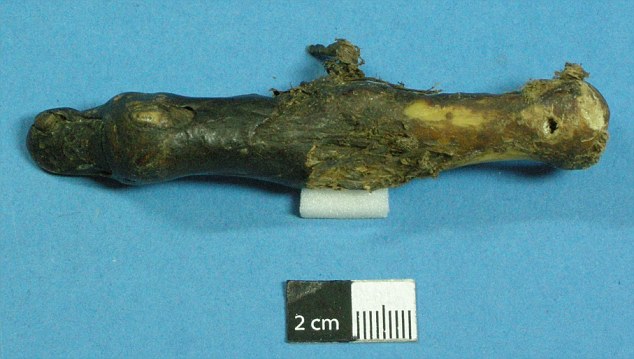
December 27, 2011
[First posted at midnight, December 27; new content as of 9:24 am Eastern, December 27, 2011. If you’ve read the background content, revised below, and are looking for the new results, see the end of this posting for updates.]

The Pangboche Yeti finger was rediscovered while on display at London’s Royal College of Surgeons. The late Dr. William Charles Osman Hill, a consultant to the Tom Slick expeditions, bequeathed it to the Hunterian Museum, which is a division of the Royal College of Surgeons.
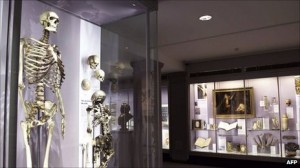
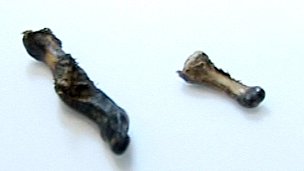
Primatologist Ian Redmond (below) examined the anatomical specimen (above) labelled “Yeti’s finger.”

The alleged Yeti finger from the Pangboche hand was found by the UK’s Daily Mail reporter Matthew Hill, several months ago and has undergone DNA testing. This certainly has been a year of surprises coming forth from the Tom Slick expeditions of the late 1950s.
Today, on a BBC program, the results of a new DNA test were broadcast. The result of the DNA analysis were announced on a program entitled “Yeti Finger” on BBC Radio 4 on December 27, 2011, at 11 am local time. (We have been posting the results as soon as we heard about them, in the “Comments” section below.)
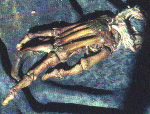
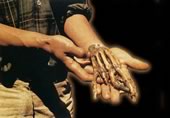
The Pangboche Hand, the so-called Yeti Hand, has been the point of much discussion since 1959, which I summarized in Tom Slick: True Life Encounters in Cryptozoology (Fresno, CA: Craven Street-Linden Press, 2002). I began further researching the material when I noticed early in my Yeti research that Tom Slick expeditions, the evidence he found, and any results were generally ignored in the “Abominable Snowman” literature. This appeared to be a combination of the Slick family’s need for being out of the limelight, the secrecy behind the Slick-Johnson expeditions, and the general outcome of the harsh skeptical debunking that occurred during the Hillary-Perkins-World Book Yeti expedition of 1960.
After the first edition of my Tom Slick book was published in 1989, and my 1991 filming with George Agogino and Peter Byrne by NBC’s Unsolved Mysteries, the interest in the Pangboche Yeti Hand and the Slick expeditions increased.
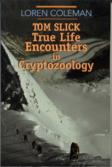
http://www.youtube.com/watch?v=75cYxUOc59o
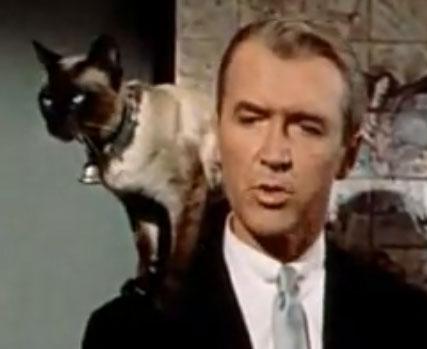
The actor Jimmy Stewart is seen here, as he appears in one of his most occult films, Bell, Book, and Candle in 1959, the same year Stewart found himself enmeshed in the search for the Yeti.
Jimmy Stewart arranged the transport (for the friend, Tom Slick, of his personal friend, F. Kirk Johnson) of the Pangboche Hand from India to London.
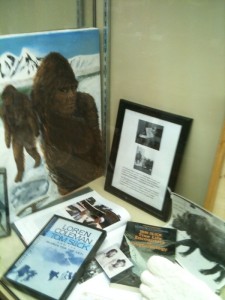
The International Cryptozoology Museum has on display a letter from Jimmy Stewart about this episode of his life, as well as original Slick-Johnson expedition materials and fecal/hair samples.

The BBC adds more about what Osman Hill forwarded to the Hunterian that were originally part of the Slick Expeditions:
…in 2008, work on Prof Hill’s collection turned up something very odd: a box of items apparently relating to his interest in crypto-zoology, the study of animals not proved to exist.
It contained plaster casts of a footprint, hair, scat (dropping) samples and an item recorded as a yeti’s finger.
The specimen was 9cm (3.5 inches) long, 2cm wide at the widest part, curled and black at the end with a long nail.
According to the notes in the box, it was taken from the hand of a yeti. Its origin was listed as Pangboche Temple in Nepal.
Now comes breaking news of a new chapter in this story, published in the Daily Mail.

Here are parts of Matthew Hill’s story published moments ago, which specifically detail the Pangboche story mostly from Peter Byrne’s point of view:
…in 1957, Tom Slick, a wealthy American oilman, funded a series of expeditions to investigate Yetis.
He became obsessed after hearing about them on business trips to India.
It was a year later, during one of the expeditions funded by Slick, that the Irish-American explorer Peter Byrne heard two Sherpas mention the word ‘Meh-te’.
When quizzed, they told him about the ancient Yeti hand preserved in the Pangboche Monastery. Days of trekking through treacherous passes with the ever-constant threat of avalanches followed as Byrne made his way to the magnificent monastery.
He remembers walking the halls by candlelight and being led to the room which contained the Pangboche hand. ‘It was covered with crusted black, broken skin,’ Byrne says.
He sent a runner over the border to India with a message for Slick about his find. It took three days for the return telegram to arrive with instructions from Slick to obtain the hand and to bring it to London.
But the monks refused to let Byrne take their revered object, explaining that if they let it go, it would bring down a curse on the monastery. Slick was determined, however. He arranged to meet Byrne in London, where they were joined by world-renowned primatologist Professor William Osman Hill.
The venue was the restaurant at Regent’s Park Zoo, where the professor was employed dissecting and embalming dead animals.
During the meal, Osman Hill told Byrne that he had to get hold of at least one finger from the hand because he wanted it to be scientifically analysed.
The professor — who had links to the Royal College of Surgeons — then reached under the table and brought out a brown paper bag.
He tipped a human hand onto the table, and suggested Byrne replace the finger with a human one.
Slick could only exclaim: ‘I take it that’s not dessert?’
Byrne returned to the monastery, and although the monks were reluctant, they eventually agreed to part with the finger for £100 — only if Byrne could find a way of disguising the missing digit.
The mountaineer wired the human finger on to the relic, before painting it with iodine to make it look the same colour as the rest of the hand. He now faced a perilous journey home.
In the previous year, the Nepalese government — bizarrely — had brought in a law making it illegal for foreigners to kill a Yeti.
Thus, Byrne took a risk by trekking on foot over the border into India with the digit. The challenge was to smuggle it back to London by plane without the authorities finding it and asking awkward questions.
Slick, as ever, had a solution. An old hunting buddy of his was in India and might be able to assist Byrne. The friend turned out to be none other than the movie star Jimmy Stewart.
Slick knew that Stewart was on holiday in Calcutta and thought he might be sufficiently intrigued by the Yeti legend to help out. So a meeting was arranged in the Grand Hotel in Calcutta with Byrne, Mr Stewart and his wife Gloria.
His instincts were right. The Stewarts were happy to go along with it. In order to dodge customs, Gloria hid the finger in her lingerie case and they flew out of India with no trouble.
Back in London, the finger was handed over to Professor Osman Hill for examination. Chillingly, his tests — which involved comparisons with human hands — concluded that it was not human.
But there the story goes cold. No more was heard of it for many years, although it is known that Osman Hill eventually bequeathed it to the Hunterian Museum, where it languished until work on this collection brought the finger to light once more.
No one knows why, after all the effort to obtain the finger and bring it back to London, it was just handed over to the museum to be neglected and forgotten.
My discovery of the finger at the Royal College of Surgeons came quite by chance during a visit, and it kindled my interest in the mystery of this strange artefact.
Having learned the briefest outline of its history, I was able to track down the now 85-year-old Peter Byrne, who was astonished.
I took him to see it at the museum. After examining the object, he verified it as the same finger he had taken. The Royal College of Surgeons then granted my request for a tiny sliver of it to be analysed in DNA tests.
These were administered by the Royal Zoological Society of Scotland and the results will be revealed in a special BBC Natural History documentary on Radio 4 today.
In general, the results could have been any of the following,
(1) Inconclusive,
(2) Unknown primate,
(3) Human/origin unknown,
(4) Unidentified mammal,
(5) Neandertal,
(6) Yeti (meaning “an unknown large anthropoid or hominoid of Nepal,” i.e. still unidentified/open-ended in identification), or
(7) None of the above.
What will this piece of the Abominable Snowman mystery reveal?
The results being discussed on the BBC program, “Yeti Finger,” appear to discuss it as an artifact of a human. More published details are coming in…
The BBC stated at 6:24 their time: “A DNA sample analysed by the zoo’s genetic expert Dr Rob Ogden has finally revealed the finger’s true origins. Following DNA tests it has found to be human bone….Dr Rob Ogden, of the Royal Zoological Society of Scotland, said: ‘We had to stitch it together. We had several fragments that we put into one big sequence and then we matched that against the database and we found human DNA. So it wasn’t too surprising but it was obviously slightly disappointing that you hadn’t discovered something brand new. Human was what we were expecting and human is what we got.’
Primatologist Ian Redmond said: ‘From what we know of accounts of Yetis, I would have expected a more robust and longer finger and possibly with some hair on the back. If one had just found it without the story attached to it, I think you would think it was a human finger.'”

Harry Trumbore’s drawing of a Yeti from The Field Guide of Bigfoot and Other Mystery Primates Worldwide
About Loren Coleman
Loren Coleman is one of the world’s leading cryptozoologists, some say “the” leading living cryptozoologist. Certainly, he is acknowledged as the current living American researcher and writer who has most popularized cryptozoology in the late 20th and early 21st centuries.
Starting his fieldwork and investigations in 1960, after traveling and trekking extensively in pursuit of cryptozoological mysteries, Coleman began writing to share his experiences in 1969. An honorary member of Ivan T. Sanderson’s Society for the Investigation of the Unexplained in the 1970s, Coleman has been bestowed with similar honorary memberships of the North Idaho College Cryptozoology Club in 1983, and in subsequent years, that of the British Columbia Scientific Cryptozoology Club, CryptoSafari International, and other international organizations. He was also a Life Member and Benefactor of the International Society of Cryptozoology (now-defunct).
Loren Coleman’s daily blog, as a member of the Cryptomundo Team, served as an ongoing avenue of communication for the ever-growing body of cryptozoo news from 2005 through 2013. He returned as an infrequent contributor beginning Halloween week of 2015.
Coleman is the founder in 2003, and current director of the International Cryptozoology Museum in Portland, Maine.
Filed under Abominable Snowman, Breaking News, Cryptotourism, CryptoZoo News, Cryptozoologists, Cryptozoology, Evidence, Expedition Reports, Forensic Science, Tom Slick, Yeti